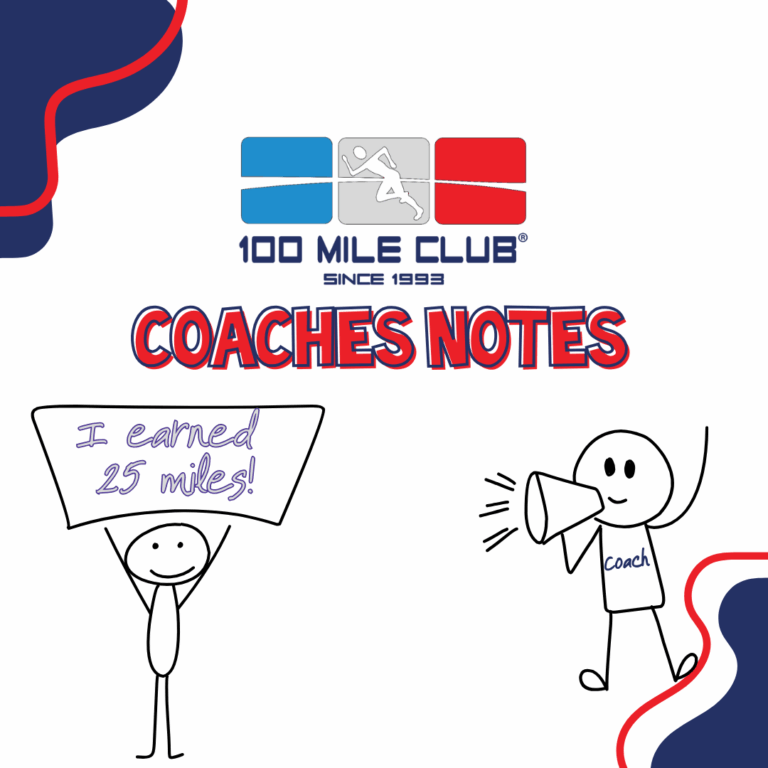Miles of fun delivered to your inbox! Join our Newsletter today!
Hot Weather Hints and Tips: Keeping your cool when the weather isn’t.
The heat is on!
Walking or running in the heat is possible and doesn’t have to leave you out of luck or stuck inside. Hot weather can often turn people away from letting their kids run outdoors, but with the proper preparation it can be done safely and enjoyably.
Benefits of Running in Summer/Warm Weather
Being active year-round is important and summer is a great time to be active (which is why we love our CLUB262 Summer Challenge!). Longer days make for extra time to get in that 60 minutes of recommended daily physical activity and extended daylight hours make running in the morning and evening much more enjoyable and feasible.
Take the following hints and tips into account before attempting to run in hot weather conditions.
Wait! Is it Ever Just Too Hot?
Every school district has guidelines specific to their region and climate, so please refer to these when making decisions about heat related activities.
The American College of Sports Medicine reports that the risk of developing heat-related illness while exercising is highest when the Wet Bulb Globe temperature exceeds 82F. The hottest part of the day is between 12-4pm and this time should be avoided on hot days. That said, one should check the air quality and the heat Index to make the best decision.
- Air Quality. Before heading out on your run, it’s a good idea to check the air quality index and the heat index. If the air quality index is code orange, and you’re sensitive to air pollution and/or have upper respiratory problems, you may not want to run. If it’s code red, it’s not suitable for anyone to run.
- Heat Index. The Heat Index tells you what the temperature feels like when combining the air temperature and the relative humidity. For example, if the air temperature is 90 degrees and the relative humidity is 70 percent, then it’s going to feel as if it’s 106 degrees. Yikes! These are not good running conditions.
The weather section of your local TV station’s website or a favorite weather app on your smartphone can usually provide up-to-date air quality and heat index information for your area.
Tips for Running in Hot Weather
 Once you’ve decided that the temperature is okay for your kids to run outside, follow these tips to keep them (and you!) safe and healthy:
Once you’ve decided that the temperature is okay for your kids to run outside, follow these tips to keep them (and you!) safe and healthy:
Tip No. 1: Acclimate. It’s all relative.
“When the weather warms, you need to be acclimated to the temperature change,” says William O. Roberts, MD, FACSM, a family medicine and sports medicine doctor at the University of Minnesota’s Phalen Village Clinic.
It can take up to 14 days to adjust to temperature changes, according to Roberts. Additionally, take in to account the severity of heat in your area. For example, a young runner living in the California or Arizona desert may tolerate heat more easily than say, a runner used to running in the cool spring weather of Maine or Washington. It’s all relative.
Tip No. 2: Stay Hydrated
When it comes to summer exercise, experts agree that the biggest concern is hydration.
To maintain good hydration for a moderate summer run, experts recommend drinking 20 ounces of water two hours before exercise, at least 8 ounces of water shortly before getting out in the heat, and then a gulp every 15 to 20 minutes during exercise. Make sure to talk to your doctor about specific fluid intake when you exercise.
To stay well-hydrated, drink fluids with food throughout the day.
“The body cools off by sweating,” says Roberts, “and as long as you remain hydrated, the body is able to cool itself off.” When you become dehydrated, the problems start.
Know the Warning Signs of Heat Illness and Dehydration: These include thirst, irritability, headache, dizziness, muscle cramping, unusual fatigue, nausea, vomiting, hyperventilation, and confusion or problems walking.
Tip No. 3: Slow Down
Walking and slow jogging is just fine…just help your kids know that they are going to be slower and that’s ok. When the temperature hits the 90s, don’t expect to go out and set a personal record, says Roberts. “If it’s hotter than you’re used to, cut the pace back or cut the exposure back,” he says.
Everyone reacts to the heat differently. Remind your kids to be careful about trying to keep up with friends who are more fit or have a higher tolerance for heat.
Tip No. 4: Wear Light, Breathable Clothing and SUNSCREEN! 
Lightweight fabrics that wick away sweat are best for exercising in the heat. Clothes should also be light in color in order to reflect the sun.
“One common problem is people overdress,” she says. “They cover up the working muscles in the legs, which generates a lot of heat.”
Sunscreen is also important when you exercise outdoors and a well-ventilated hat with a brim and some lightweight sunglasses can protect your face and help prevent headaches.
Tip No. 5: Exercise Early or Late
If possible, get out before 7 a.m. or after 6 p.m. to exercise in the summer months, says Roberts. This will add length to your day, and energy to your summer workout.
Tip No. 6: Use Common Sense
When you don’t know what to expect or how your kids will take to the activity, it’s best to save it for a cooler, more forgiving day, he says.
“The biggest thing with heat and exercise,” says Branch, “is common sense. If you’re feeling bad, you need to get inside, get your core temperature down. It’s just not worth it.”
Tip No. 7: Take Breaks. 
Don’t hesitate to take a break halfway through to head inside for a cool-down or a nice rest under some shade. Nothing that feels better than a cool, wet towel, a spritz of water from a spray bottle, or even running through sprinklers! Whatever you do, plan on taking breaks at least every 10-15 minutes when it’s super warm.
Tip No. 8: Consult Your Doctor or Pharmacist
Many medications — both prescription and over-the-counter — can intensify the effects of heat-related illnesses, says Roberts. They can hasten dehydration and decrease the body’s ability to recognize danger.
Know your kids and watch them carefully on hot days.
Tip No. 9: Make the decision and trust your gut.
If you or your supervisor decide it’s just too hot, make the decision and stick to it. Better to be safe than sorry. Explain the dangers of running in hot weather conditions and why preparing, postponing, or moving inside is important.
- Take it inside. Set up a course inside your gym or under a shaded path (awnings or covered hallways). Kids get a kick out of running the halls when they are normally told to only walk.
- Play some games. Play an indoor running game, relay, or dance it out! Then equate your minutes to miles and give them credit. Sometimes you just need to get creative to get your “miles” in! As a rule of thumb, we will call 20 minutes on moderate to vigorous physical activity (heart rate elevated and engaged, active movement) one mile.
The most important thing always is the health and safety of your runners. Always err on the side of caution, be mindful of school district policies, and remember that whenever possible, being outside is the best thing ever for kids (and adults too). Enjoy!
Resources:
http://www.active.com/running/articles/10-tips-for-hot-summer-runs
http://www.webmd.com/fitness-exercise/features/exercising-in-the-heat#2
http://www.active.com/fitness/articles/7-safety-tips-for-training-in-hot-weather
http://www.acsm.org/public-information/articles/2016/10/07/preparing-for-and-playing-in-the-heat
http://www.weather.gov/tsa/wbgt
For a printable version of this article, please click here.





